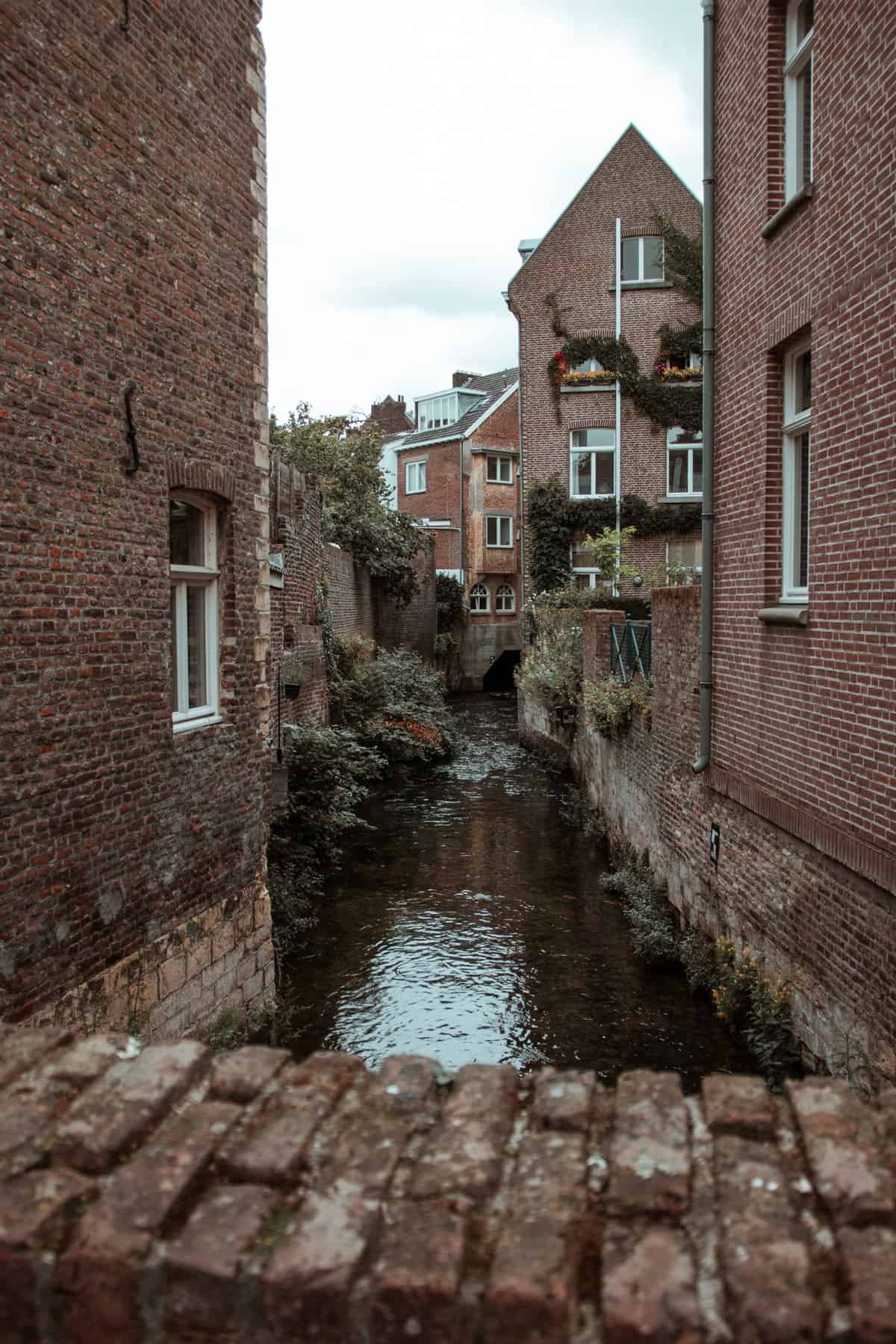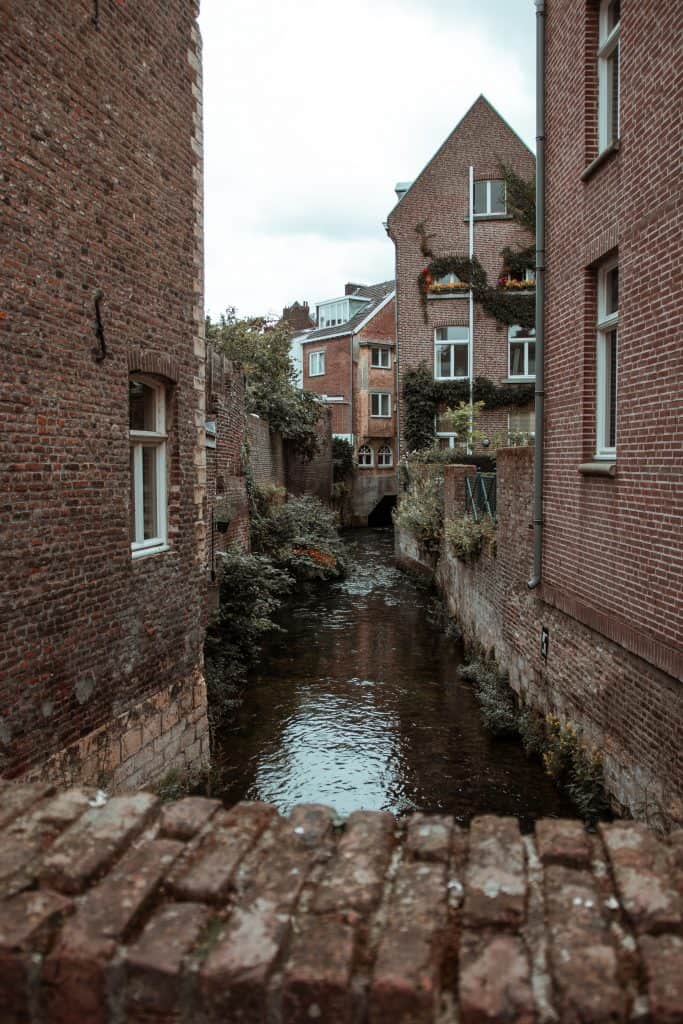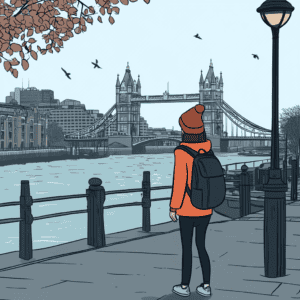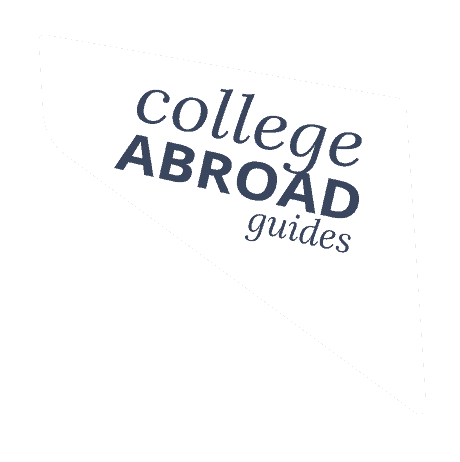Beauty and Brains: Attending University College Maastricht for Liberal Arts and Sciences

- Originally published
- Last updated on September 1st, 2023 at 02:47 pm
Table of Contents
Maastricht is a historical college in a gorgeous city. In the southern, Catholic tip of the Netherlands, it brings together multiple cultures and a strong European mindset. What’s it like to attend?
The EU was founded in Maastricht in 1992, giving us the Euro and a united European mindset.
That mixture of nations and philosophies is evident at University College Maastricht.
Maastricht seems to allow its access to an unbeatable mix of teaching and research resources. It’s a small, rigorous college sitting among the resources of a huge university comprised of 56% non-Dutch students. It’s focused on undergraduate learning, but adjacent to a research powerhouse.
We’re checking out the diverse resources and feel of this gorgeous town.

The Basics of UC Maastricht
Associated with: University of Maastricht
Degrees: BA, BSc
Concentrations: Sciences, Social Sciences, Humanities, or a combination
Location: Maastricht, Limburg, NL
English: All-English in the UCM, with some University of Maastricht classes, like Dutch law, Health Sciences, and Tax Law taught in Dutch. Medicine and psychology are taught using both English and Dutch.
Cost for out-of-European Economic Area (EEA): €10,900
On-campus housing cost: None is available. Private housing corporations and social media help students find housing in this comparatively affordable Dutch city. Private rooms in a shared space will run about €400/mo.
FAFSA funds: Yes
Abroad from abroad: Yes, there are exchange students who come to study at UCM as well as UCM students who go abroad to one of 50 partner universities (typically in the 5th semester) across six continents. Most of those universities offer instruction in English.
Student body: Admits 225-250 students annually. Fifty countries are represented, with over 100 nationalities making the bigger University of Maastricht home. 70% of UCM students have some experience living internationally.
Five adjectives: authentic, charming, continental, challenging, diverse
University College Maastricht Ranking
U.S. News ranks University College Maastricht’s parent university #189 globally, #78 in Europe, and #10 in the Netherlands, with standout programs in medicine. One ranking that might interest university college prospective students is the social sciences and public health program.
Fields that are popular at the liberal arts and sciences school take advantage of the medical and biological sciences offerings of the greater university and include things like forensic psychology or neuroscience. Psychology students will also find their faculty highly rated, globally ranked #89 at EduRank.
In the Times Higher Education Rankings 2021, Maastricht ranks #121 globally, with high marks for the international community. It attracts both many international students and staff.
The QS Rankings put Maastrict at #233 globally. Maastricht scores highly on the rankings of young universities. Although the city is medieval, the University of Maastricht only dates from 1976.
Keep in mind rankings consider the parent universities and cannot speak to the differences in teaching undergraduates that the University College Maastricht liberal arts and sciences program offers, which are quite selective and elite compared to non-honors college offerings elsewhere in the university.
Is it Hard to Get into University College Maastricht?
University College Maastricht is a moderately selective honors college program that admits an average of 250 students annually. The university colleges in the Netherlands are all selective. That means admissions committees will not admit everyone who meets the credentials. Some will be invited to an interview, and fewer still will be offered admission.
Because University College Maastricht has no campus housing, the program does not need to limit the size of its first-year classes. That’s good news and bad news.
The school can admit a lot of students, increasing the chances that prospective students get offered a spot. But there’s a realistic chance students get admitted and can’t find housing in the city.
In keeping with the Dutch sensibility that all who desire education should have access to it, students find it relatively easy to get into this elite program (at least compared to elite American schools).
However, staying in and keeping up is another story. The fast pace of the program can mean students drop out in higher numbers than at America’s rigorous institutions.
Is University College Maastricht a Good University?
Yes. University College Maastricht’s liberal arts and sciences program serves as a small-scale honors college within the research university of the University of Maastricht. Maastricht is already the most international program in the Netherlands.
The university college doubles down on this global approach and boasts a wide range of student perspectives as one of its core selling points. The problem-based learning approach gets high praise from students who say it helps them focus their studies on difficult challenges and begin to see themselves as problem-solvers for a complex world. Netherlands universities, in general, are world-class, and University College Maastricht is no exception.
One student told us she felt prepared for her master’s degree program because she had already published research in UCM’s peer-reviewed student journal in her second year and then gone on to assist a Ph.D. student with research in her final year in the program. There is even the opportunity to apply to an intensive third-year research project to prepare future academics for professional research.
Big-University Resources
While we believe Maastricht is hands-down the #1 university in the Netherlands for sheer gorgeous ambiance (that’s totally a category worth ranking), the school does not have a formal campus at all.
Instead, the university takes up space in a historical quarter of the city with green squares, lofty trees, old city walls, and plenty of picnic spaces.
University College Maastricht has its own building so students can hand out there and get to know other students while having a smaller-scale experience than students in other programs.
They can also branch out, walk a minute away, and use the cavernous University of Maastricht library to study. That’s a big bonus, since other university colleges are far from their parent universities, and students often complain to us about the one-room library systems, often smaller than their hometown libraries.
The big university also offers other services you won’t find at smaller university colleges to this scale. At University College Maastricht, you’ll be able to see counselors for personal life issues, psychologists, disability resource staff, and career offices.
The City of Maastricht
Bordering Belgium and close to Germany, Luxembourg, and even France, Maastricht is an undeniably international town. You’ll hear residents and tourists speaking French and German here. You may possibly even find yourself confused when strolling by an outdoor café and catching wind of a “bonjour.” It shouldn’t be a surprise that Maastricht has a strong global vibe.
There are other great benefits to life in Maastricht. The pedestrian-only town center is massive and custom-made for foodies, with the highest density of restaurants in the Netherlands. Market days on Fridays can have up to 200 stalls, full of flowers, fresh veggies, and yummy, affordable cheese.
Historical Maastricht
Walk a little off the beaten path, and you’ll find some unique historical novelties like a working water wheel, the Bishop’s Mill, that grinds flour for its bakery just as it did when it was constructed in the 11th century.
Wanderers also find they crisscross through gates in the medieval walls of the old city, taking breaks in shady plazas with 17th-century buildings, where university facilities and students dominate.
“One thing I think is that it has compact, but big city vibes. It’s a real city but somehow has small town vibes because you keep running into the same people and there’s so much nature close by!”
This is the Jekerkwartier District (named after the river), the historic center of university life. It’s near the central city, just south of the main central business district of Maastricht. The quarter is home to upscale stores, parks, and large public squares.
Historical Hangouts
The western side of Jekerkwartier, called the Quartier Latin, is where most of the student action is.
In addition to the Performing Arts College where you can catch a student play, you’ll see the conservatory, plenty of art galleries, and bars with live music. Try taking a group of friends to a “brown café” (a casual pub, full of dark wood, exposed brick walls, and warm food) like De Preuverij next to the student center.
The entire neighborhood feels medieval because it is.
Around 1200, Franciscan monks established a monastery in the Jekerkwartier. Soon after, easy access to water from the Jeker river made this spot popular with tanners. It became a vibrant, if smelly and polluted, district. Today, you can read up on the Jekerkwartier’s economic history in the library, historically used as a poorhouse, but now part of this gentrified, well-heeled neighborhood.
Awesome Student Spots
Maastricht has a bustling atmosphere that belies that the town is only home to 120,000 people, 20,000 of whom attend the University of Maastricht.
If you’re looking for a modern, inspiring place to study and have a coffee, cross the river and spend time in the cultural center, Centre Ceramique. This exhibition space and library has a coffee shop and plentiful laptop plugs. The coffee is from a Maastricht staple, Coffeelovers, which can also be found in the city’s (the world’s?) most aesthetic bookstore: the Dominicanen bookshop housed in a towering, stone, 13th-century church nave.
History buffs should tour the caverns underneath the city at Sint Pieter, or try biking to nearby castle ruins. Those working to overcome the seasonal affective disorder that seems to descend over the Netherlands in mid-February will be pleased to know that a massive Carnival celebration offers a colorful break to the rainy season.
Campus Resources
UCM is more integrated with the University of Maastricht than many other university colleges, and university life is also woven into the fabric of Maastricht itself. One current student says one of the reasons she loves UCM is because it is set in the beautiful city of Maastricht, and that “there is no campus.” However, while the university exists within and among the city, that doesn’t mean its facilities aren’t breathtaking.
“When I walked into UCM, I was immediately sold.”
UCM houses its UC program in the Nieuwenhof (New Court) convent building, up against the old city walls and adjacent to an extensive park. Nieuwenhof itself is historical and stunning. It was a female-centered religious gathering place that differed from a convent but provided women of the era, called Beguines, a place to live a communal, religious life while maintaining their own residences.
The Beguines were a lay religious order that did not take formal vows or live with the constraints that a convent life would entail.
When the university took over the space in the early 1980s, it inherited an inspiring reading room and outfitted it with a modern, undulating ceiling without disturbing the medieval wood beams and cozy feel.
The lecture hall has taken over a 15th-century chapel, and the cloistered courtyard hosts sunny day hangouts and open mics. There is an informal lobby common room for students to chill out on couches and make plans for after class, or study in between tutorials. There’s a computer area, student association, and student services located in Nieuwenhof itself, giving UCM students a home base and a strong sense of community.
A green belt cradles the south side of campus.
Campus Life and Gender Disparities
A study association, Universalis, plans readings, movie nights, fundraisers, trips, and social events for UCM students. However, be warned that socializing can be lopsided. One 2016 student newspaper article reported that the male/female ratio at the University of Maastricht was 31% male to 69% female.
This is the norm in Dutch university colleges (other than at male-dominated and technology-minded University College Twente), but Maastricht has pathologized the phenomenon, calling it Maastricht Syndrome or just “The Maastricht Effect” – a citywide malaise where awkward guys get hit on more often than they otherwise would because of the shortage of eligible men in town.
University College Maastricht Accommodation
No Residency Requirement, No Residences
The only other university college in the Netherlands with no residency requirement is the University College Tilburg. In fact, there is also no university housing at all at the University of Maastricht, including UCM. In true Dutch style, it’s a community and a campus, but housing is up to students.
Consequently, there’s no option to live in a dorm setting with other UCM students for incoming international freshmen. Instead, the student city of Maastricht is bustling with Facebook groups, agencies, and all kinds of ways to find your own student accommodation.
That’s not to say it’s easy.
Many students complain that the process is difficult for international students to accomplish from abroad.
Finding Housing Near Campus
Students can use Maastricht Housing, the university’s housing agency, which can help matchmake student accommodation. There are a couple of Facebook groups like Maastricht Room Search, as well as agencies, some of which come with hefty registration fees, which do not guarantee housing.
The University College is 50-70% international, even in the bigger University of Maastricht, which means that the housing scuffle can be frustrating for lots of students, none of whom know how to navigate common scams to lock down housing.
The most common advice is to register for multiple agencies early to maximize your chances of finding housing. One Dutch student says the difficulty has been manageable, saying she expected it to be as hard as Utrecht or Amsterdam and ultimately found the housing search a breeze in comparison – and less expensive, too.
There is a flip side to this housing stress: Maastricht appeals to free spirits because it does not require students to live on campus. One student says that’s exciting because it has allowed her a typical Dutch experience she couldn’t have gotten in a dorm or apartment: renting a private room in a “studentenhuis” (rental house with other students).
“I really wanted to experience the Dutch student life of living in a student house rather than on campus. UCM is the only Dutch UC I know of that doesn’t require its students to live on campus! So far, I love my experience at UCM.”
University College Maastricht’s Program
The University College Maastricht liberal arts and sciences program is one of the more science-focused university colleges (along with Amsterdam University College and University College Twente’s specifically tech-focused program).
However, humanities and social sciences students can feel at home here.
Students can choose a concentration in either humanities, social sciences, or sciences. There’s no preference for students in any of these concentrations. However, medicine and biomedical sciences are popular offerings, and UCM also seems to emphasize medicine in its videos on the problem-solving model.
There are roughly 150 courses, and students will be required to take electives within their concentration and some outside it, for a liberal arts education with depth and breadth at the end of the program.
Overall, the school’s active learning approach equips students to be engaged, critical thinkers, and creative problem solvers. Want to solve global warming or race conflicts? This is the place to consider large, complicated social problems from all angles.
Small Classes and Breakout Sessions
Maastricht has some of the smallest classes of all the university colleges. Classes average 12 students, guaranteeing personalized attention. That also means attention from an academic advisor (called a tutor) who walks students through choosing their classes.
Tutors also manage breakout sessions and help students run the discussion themselves. They help keep conversations on track and point out problems when needed. One American student says that the tutors were “incredible.” With small classes, she says she got tons of personal feedback, support, and guidance.
“Although all the UCM students I have met so far are highly motivated and intelligent, they are also very nice and chill people to be around!”
The twist that Maastricht puts on their university college curriculum is that every course will utilize a problem-based learning (PBL) approach.
This student-centered approach improves student collaboration and research skills, as students must figure out what they need to know to solve the problem and get it for themselves. Classes center around a real-world issue, and students must work together to formulate and implement a solution. For example, they’ll contemplate how to remove waste from the local river or how to encourage healthy eating in high schools.
Problem-Based Learning
One Dutch student says PBL has been the best part of her educational experience at Maastricht.
However, other students say the approach is intense, and the workload is too heavy.
“It was much harder than I expected as I somehow missed that it was an honours college (oops) but I love the intensity so luckily, it did not bother me.”
Still, many students say they chose Maastricht because of its reputation as one of the most rigorous programs available.
A Smorgasbord of Classes
There are 150 courses from which to make a personalized curriculum, but every student starts with a four-course “academic core”: Contemporary World History, Political Philosophy, Philosophy of Science, and Science, Reason, and Human Progress. UCM requires skills coursework.
Students can choose research skills coursework from various areas, like ethnographic interviewing, applying an art practice as a research method, or biochemistry lab skills. Students complete a project each semester.
Finally, a capstone project is a significant academic undertaking that combines a student’s learning into a meaningful piece of scholarship.
One student says that she was able to publish in the university’s peer-reviewed journal in her second year and complete research with Ph.D. students in her third year, ultimately leading to her feeling highly capable in her new master’s program.
The student’s major is typically in one of the concentration areas, though combining two areas is also possible for students whose interests span two disciplines.
“Everything was a surprise! I had no clue what to expect. I don’t feel that I understood what it meant to receive an interdisciplinary education before beginning my studies but I caught on quickly.”
In their first year, students take elective coursework outside their discipline in order to achieve the breadth of liberal arts experience. This requirement comes with many choices, though, as students can opt into courses and issues that interest them. In the end, like all the university colleges, UCM prepares students to excel in graduate school in a narrow specialization within the context of a broad, liberal arts education.
University College Maastricht Students
Maastricht students are a highly international bunch. The research university offers a broad international student body, and the university college offers a typically robust international presence, as expected. UCM’s program includes students from fifty countries. Seventy percent of students have an international background — and many come to the program for its international atmosphere and to be around other international students.
The school embraces its global roots with a commitment to diversity and inclusion. And as one a UC attached to a large, research school, resources for diverse students across a spectrum of identities and needs are better than at many other small UCs.
How to Apply
UCM requires that American applicants have an International Baccalaureate degree (IB) or 3 AP exams with a score of 3 or higher. You can also have a successful year of college substitute for AP exams.
This school was the first US we saw that encouraged students with different credentials to submit SAT/ACT scores, as they believe students can show off their academic capability in multiple ways.
There’s also a letter of motivation, a CV, and an English proficiency requirement for students whose native language is not English. UCM invites 65% of qualified applicants to an interview. They offer 250-275 students each year admission. You can apply through Studielink, choosing the University of Maastricht’s liberal arts – UCM program.
University College Maastricht admits students for both the fall and spring semesters, so there are application deadlines in September and February.
The college has a substantial scholarship program for low-income, non-EU students, awarding five full scholarships to bachelor’s degree applicants covering the costs of tuition, fees, health insurance, and housing for all three years.
Check Out the Competition
Look into University College Utrecht or University College Roosevelt, so you’re sure your choice is the perfect one for you. Or head to the basics for information on going to college in the Netherlands.
Related Posts

Jessica Share
Jessica is the writer, Ph.D., and mom-of-an-abroad-student-in-the-UK at the helm of College Abroad Guides. When she's not asking college students where the coolest place to hang out in their city is, she's figuring out how she can make $60 imported Greek oregano potato chips and £50 British bacon potato chips appear on her doorstep for the cost of a local bag of Lay's.





